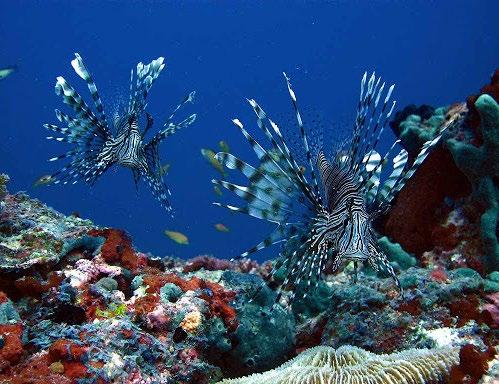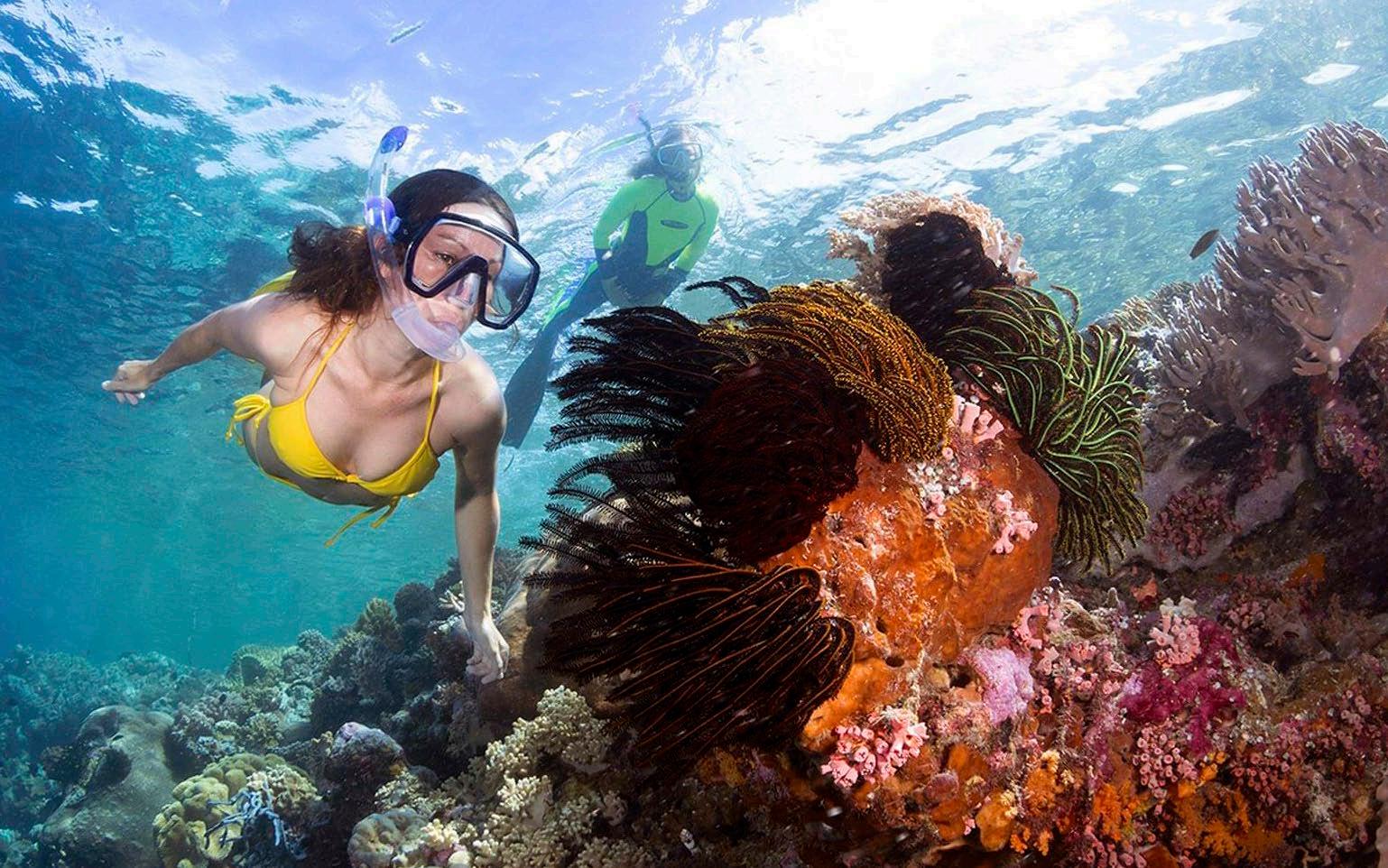
9 minute read
DIVING
Wakatobi The Dive Island of the Maldives
Wakatobi, located at the world’s epicenter ofcoral reef biodiversity, isa designated UNESCO Marine Biosphere Reserve that attracts discerning divers from across the globe. The world-class destination combines an upscale diving operation delivering exceptional service to its guests with a reef conservation program which, in guaranteeing the pristine quality of the reefs for those guests, delivers sustainable income and development support to the local communities. As you arrive on the island of Wakatobi, you cannot help but feel a million miles away from the the daily grind. In the secluded location of this island there is no traffic noise, no pollution and no other divers for at least 100 miles. However, despite the remote location, Wakatobi Dive Resort offers a very civilised existence. Accommodation comes in the form of hand-crafted villas and bungalows, each spacious, quiet, comfortable and just a few steps from the ocean. All are air-conditioned with wi-fi satellite internet access, along with comprehensive amenities. All your meals and snacks (chefprepared in the beachside restaurant) are included throughout your stay, and so divers are well and truly looked after and fueled ready for their next adventure. Whether you are diving or snorkeling amongst the vibrant protected coral reefs bristling with marine life, enjoying a rejuvenating spa at the resort, taking in a glorious sunset with your favourite cocktails at the jetty bar, or perhaps indulging in a romantic beach dinner, Wakatobi Dive Resort provides a unique and enriching experience. Whilst divingat Wakatobi, youcansee the greatest variety and diversity of marine life. You’ll not only see beautiful vistas or pristine coral reefs, but also abundant colourful reef fish and rare and unusual cryptic ‘critters’. New and undocumented species continue to bediscovered at Wakatobi.There are, of course, other locations where you can see larger schools of fish, bigger animals and experience more adrenaline-filled underwater‘rides’, but for sheer reef scenery and marine life variety, Wakatobi simply has to be experienced to be believed. For sheer reef scenery and marine life variety, Wakatobi simply has to be experienced to be believed.
Advertisement


The Wakatobiregion is considered to be the epicenter of coral reef biodiversity. 85% of the world's coral reefs are located in the Indo-Pacific region, and as you travel either east or west from the epicenter of biodiversity, the number of species decreases. At the Western edge of the Indian Ocean, or the Eastern edge of the Pacific, you will only find about 25% of the number of species that are present at Wakatobi. The Atlantic/Caribbean region has even less diversity, less than one tenth the number of species found in the Indo-Pacific. For instance, the Atlantic/ Caribbean region has fewer than 70 species of corals while the Indo-Pacific has over 700 species. The environment influences biodiversity. Coral reef ecosystems need warm, clear waters to thrive. If there’s too much runoff from large rivers or urban growth nearby, the reefs can be choked by siltation or pollution. The waters must be warm, but not too warm. Below 25 C, coral growth is retarded. Above 29 C, the symbiotic algae living in the corals begins to die off and stress the corals. Depth is important too. Very shallow waters have too much temperature fluctuation and disruptive wave and surge action. Too deep, and light is diminished, which decreases diversity. At about 20 M depth, there is plenty of light, and not much wave action, even during large storms, so more species can survive. Wakatobi itself is blessed with more than 50 mapped and named dive sites all within a short distance of the main resort, all accessible by the resort’s day boats. Boat rides range from 10 minutes up to a maximum of an hour for a few of the furthest sites. The reefs around Wakatobi are actually continuous, so to call a dive site a ‘site’is a little misleading. Most of the dives sites are identified at locations on the continuous reef where dives are started and the team have generally selected these starting points because of some unique underwater typography or marine life that is common to this spot. Nowhere else do you have suchease of access to miles of pristine reefs with diverse topography, life and highlights. In other locations you collect the good dive sites together over large areas with perhapslong and arduous boat journeys in between and mightnot even get close to what Wakatobi offers out there right at the doorstep. In Wakatobi you can enjoy diving 365 days a year. There is no period or season unsuitable for diving, with only 4 dives being skipped in the last 10 years. The climate is drier than in other parts of Indonesia, and the location is nicely protected by the surrounding reefs and islands.


Generally speaking there are two seasons: Easterly winds from June to October, and Westerly winds between December and April. November and May are usually transitional months. July and August see a slight increase in wind, and the sea ripples somewhat; visibility is still fine. The weather in these months is a little cooler than the months on either side, making it a great time to visit for those who prefer to sleep without using an air-con- ditionerat night. The temperature in Wakatobi generallyranges between 26 - 30 degrees Celsius, making the resort a year-round holidaying spot and perfect winter sun escape! When it comes to water temperature, the warmest water in Wakatobi is found in the upper water layer around late October, when temperatures may reach30 degrees Celsius (86 degrees Fahrenheit). The coolest time falls in the latter half of August with a minimum temperature of26 degrees Celsius (78 degrees Fahrenheit). From March until May the temperature averages 28 degrees Celsius (82.4 degrees Fahrenheit), June averages 27 C (80.6 F), July 26 C (78.8 F), September is between 26 - 27 C (78 - 81 F), October 28 to 30 C (82 - 86 F). From November until March the temperature averages 28 - 29 C (82.4 F- 85 F). The water temperature range is ideal for coral growth and there is no coral bleaching in Wakatobi. Underwater visibility is phenomenal, being mostly between 20 m and 50 m, with an average of 35 m or 100 feet. There are no rivers or lakes bringing sediments, therefore visibility is not affected by rain. Known as the ‘house reef,’ shore diving at the Wakatobi Resort is world-famous. Some guests never even on a boat dive because the reef and wall right in front of the resort provides enough territory and diversity to keep them exploring for several days. There is no need to swim long distances as divers are offered 'taxi-boat' services to transport you them up current to extended parts of the House Reef to explore or enjoya beautiful drift back to the jetty. Wakatobi’s House Reef is a cornucopia of marine life and snorkelers can wade in directlyfrom the beach or enter from the jetty ladder.The seagrass shallows are refuge to species such as filefish, coconut octopus and halimeda ghost pipefish, while areas surrounding the various coral heads host numerous colourfulju- veniles, cuttlefish, crocodilefish, moral eels, juvenile green and hawksbill turtles and more. Additionally, at least seven species of anemonefish have been counted in the area surrounding the jetty and Jetty Bar! The dramatic drop off where the House Reef wall begins offers glimpses out into the blue and down the wall - turtles, bumphead parrotfish, rays, mild-mannered triggerfish, boxfish, pufferfish and midnight snapper can be seen among many other species. Snorkelers (and freedivers)at Wakatobi receive the same level of support as scuba divers. All of the dive sites are rated forsuitability for snorkelling based on thereeftopography. Snorkelers who join the morning and afternoon boat excursions are accompanied by a professional snorkel guide who is versed in the marine life found on our reefs. Snorkeling equipment as well as camera and video systems are handled by the team and will already be on the boat when you step aboard. Towels, snacks and camera assistance are also provided and the boat crew constantly monitors snorkelers while they are in the water.


The House Reef is monitored by shored-based staff, who also have access to a taxi boat if needed. Additionally, if you are a lessexperienced snorkeled, you can engage a Private Snorkel Guide to assist with your snorkeling skills, marine life encounters and anything else to help you get the most from your snorkeling experience. Guests can even night dive any night on the house reef in front of the resort. Simply gear up in the diver preparation area and walk-in off the beach! The team behind the Wakatobi Dive Resort pride themselves with staying at the very forefront of innovation, offering exclusive and pioneering dive experiences to their visitors. Fluo Diving is an example of this, allowing visitors to experience a new dimension in diving so exclusive that more people have seen Earth from space than have seen corals in this totally new light! Not to be confused with phosphorescence, or bio-luminescence, fluorescence is the absorption of one wavelength of light (or colour) and the re-emission of another, totally different wavelength of light (or colour). A fluorescent object under white light reveals its true colour. But under near UV light, it absorbs the blue and re-emits a fluorescent colour, transforming the blue into a brightly glowing, totally different colour. Thus, underwater, marine animals that fluoresce have the ability to convert one colour into an entirely different colour! Beneath the glistening surface of the Wakatobi waters lies a photographer’s paradise, with unbounded opportunities for underwater photography and videography, ranging from dramatic drop offs, breathtaking coral gardensand pinnacles for wide angle shotsdown to the most minute and exotic marine creatures for macro fanatics. The exuberant vitality of the reef systems means that whether pro or leisure photographer, every dive will deliver anawesome array of images in your viewfinder. With many of the guests being underwater photographers, the resort provides state-of-the-art facilities for working on your camera. The camera room is climate-controlled and has large work tables and storage shelving for all your camera gear and the workbenches have cushion pads to protect your equipment. The team provide voltageregulated power to charge all your batteries and there is plenty of light to allow you to work on your camera. Perhaps one the most appealing factors that keep divers returning year after year to Wakatobi is the fact that their stay at the resort supports the protected conservation zone. The entire Wakatobi region has been turned into a sustainable protected marine park. The local village and surrounding communities have enthusiastically adoptedthe conservation plan and as a result, illegal fishing, reef walking and other activities detrimental to the coral reef have been halted. Part of visitor’s payment for staying and diving at Wakatobi goes back to the community to sustain and support this new way of living; living in harmony withand in respect of the coral reef ecosystem.


www.wakatobi.com












